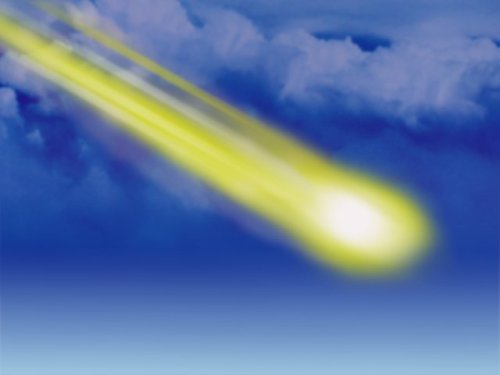WASHINGTON, (AFP) - A NASA scientist's claim that he found tiny fossils of alien life in the remnants of a meteorite has stirred both excitement and skepticism, and is being closely reviewed by 100 experts.
Richard Hoover's paper, along with pictures of the microscopic earthworm-like creatures, were published late Friday in the peer-reviewed Journal of Cosmology, which is available free online.
Hoover sliced open fragments of several types of carbonaceous chondrite meteorites, which can contain relatively high levels of water and organic materials, and looked inside with a powerful microscope.
He found bacteria-like creatures that he calls "indigenous fossils," which he believes originated beyond Earth and were not introduced here after the meteorites landed.
"He concludes these fossilized bacteria are not Earthly contaminants but are the fossilized remains of living organisms which lived in the parent bodies of these meteors, e.g. comets, moons, and other astral bodies," said the study.
"The implications are that life is everywhere, and that life on Earth may have come from other planets."
Studies that suggest alien microbes can be contained in meteorites are not new, and have drawn hefty debate over how such life could survive in space and how and where life may have originated in the universe.
The journal's editor in chief, Rudy Schild of the Center for Astrophysics, Harvard-Smithsonian, said Hoover is a "highly respected scientist and astrobiologist with a prestigious record of accomplishment at NASA."
"Given the controversial nature of his discovery, we have invited 100 experts and have issued a general invitation to over 5,000 scientists from the scientific community to review the paper and to offer their critical analysis,"
he said.
Those commentaries will be published March 7 through March 10.
A NASA-funded study in December suggested that a previously unknown form of bacterium had been found deep in a California lake that could thrive on arsenic, adding a new element to what scientists have long considered the six building blocks of life.
That study drew plenty of criticism, particularly after NASA touted the announcement as evidence of extraterrestrial life. Scientists are currently attempting to replicate those findings.
 |
(MCT) |
<한글 기사>
NASA 과학자 "운석서 외계생명체 발견"
100명의 전문가, 리처드 후버 박사 주장 분석 중
미항공우주국(NASA)의 한 과학자가 운석 파편에서 외계 생명체의 화석을 발견했다고 주장, 흥분과 의구심을 동시에 일으키고 있으며 현재 100명의 전문가가 이 주장을 면밀히 검토 중이다.
NASA 마셜 우주비행센터의 우주생물학 연구단장인 리처드 후버 박사는 수분과 유기물이 비교적 다량 함유된 몇 종류의 탄소질 구립(球粒) 운석 파편을 절단해 강력한 현미경으로 관찰한 결과, 박테리아처럼 생긴 형체를 발견했다면서 이는 유기물의 화석이라는 주장을 사진과 함께 코스몰로지 저널 최신호에 발표했다.
후버는 미세한 지렁이처럼 생긴 이 형체가 지구 아닌 다른 곳에서 온 `외계 토착 화석'이라면서 운석이 지구에 떨어진 뒤 다른 물질로 오염된 것은 아니라고 강조 했다.

그는 "이 화석화된 박테리아는 지구상의 물질로 오염되지 않았으며 이것은 모체인 혜성이나 위성, 다른 천체에 살았던 생명체 유기물의 화석화된 잔해"라고 주장했다.
후버 박사는 이런 발견은 "생명체가 우주 어디에나 존재하며 지구상의 생명체는 다른 행성으로부터 왔을 가능성이 있음을 의미한다"고 말했다.
운석 속에 외계 미생물이 있을 수 있다는 연구가 처음 나온 것은 아니며 이런 연구들은 우주에서 생명체가 어떻게 생존하며 우주에 생명체가 생긴 시기와 과정이 어떤 것이냐에 관해 많은 논란을 낳고 있다.
동료비평 학술지 코스몰로지의 편집장인 하버드-스미스소니언 천체물리학센터의 루디 실드 박사는 "후버는 존경받는 과학자이자 천체물리학자로서 NASA에서도 탁월한 연구 업적을 인정받는 인물이지만 주제 자체가 워낙 논란의 여지가 큰 것이라 전문가 100명의 의견을 구하고 있다"고 밝혔다.
그는 이 밖에도 5천여명의 과학자들에게 후버의 연구 보고서를 비판적으로 분석, 평가해 줄 것을 요청했다고 덧붙였다.
앞서 지난해 12월에도 NASA의 지원을 받은 학자들이 미국 캘리포니아의 호수속에서 비소를 먹고 사는 미지의 박테리아를 발견했다고 발표해 학계에 충격을 주었다.
NASA는 이런 연구 결과를 발표하면서 외계 생명체가 존재한다는 증거라는 입장을 밝혀 많은 비판을 받았다. 이 연구를 발표한 과학자들은 발견을 재현하는 작업을 진행 중이다.
(워싱턴 AFP=연합뉴스)







![[Today’s K-pop] Blackpink’s Jennie, Lisa invited to Coachella as solo acts](http://res.heraldm.com/phpwas/restmb_idxmake.php?idx=644&simg=/content/image/2024/11/21/20241121050099_0.jpg)